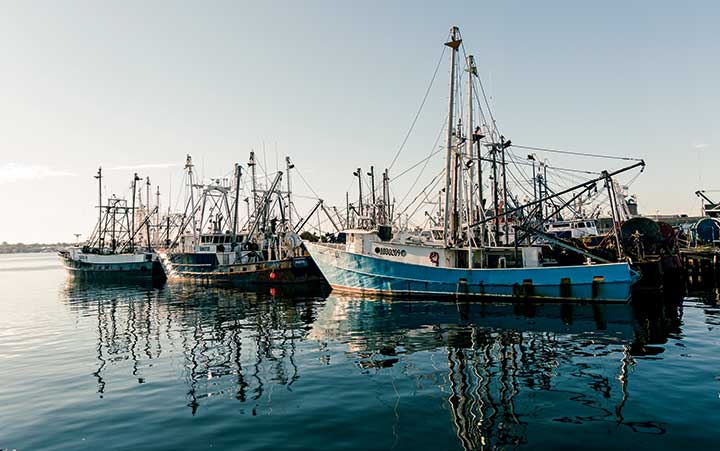Massachusetts
New Bedford, Massachusetts | Whaling Industry History
New Bedford, Massachusetts, embodies the grit and the tragedy of the whaling industry. Learn more about its rich maritime history.

New Bedford Harbor, a working fishing community and a deepwater commercial port.
Photo Credit : Carl TremblayThe long, sloping, cobblestone streets of New Bedford’s historic district come to a screeching halt at the shore. The boutiques and bistros are separated from the water by an intimidating four-lane highway. Beyond that, the warehouses and riggings of the town’s working waterfront rise up like a wall, telling tourists they’ve strayed out of bounds. Here, the harbor still belongs to those with sea legs. “We still have that authenticity,” boasts Emily Prigot, a ranger at the New Bedford Whaling National Historical Park. “We haven’t been gussied up for the visitors.”
If Mystic embodies the beauty and romance of the sea, New Bedford is the grit and the tragedy. In the 1850s, whaling made New Bedford the richest city per capita in the country, but that distinction came at a high human cost. Whaling voyages were grueling, dangerous affairs. Ships stayed out at sea for years at a time, and if the whales didn’t kill you, disease and malnutrition easily might. There’s a reason that only one person walks away at the end of Moby-Dick.
[slideshow post_id=”554496″]
Whaling may be the only profession in history that is most commonly represented in art as things are going horribly wrong. Inside the galleries of the New Bedford Whaling Museum you’ll find countless images of longboats being crushed by flukes or dragged along in “Nantucket sleigh rides”—when the harpooned whale flees across the surface rather than sounding, smashing the boat and its crew against the waves in the process. This is what the casual observer of whaling wanted: epic fish tales of brave men battling the monsters of the deep. But in New Bedford, whaling was a business, and its residents have never forgotten the toll the ocean exacts on those who labor on the open waters.
Just down the street at the Seamen’s Bethel, the sad history of the New Bedford fleet is written on the walls. Ringing the interior of the solemn meetinghouse is a series of marble cenotaphs, hollow graves commemorating those lost at sea. The list goes right up to the 21st century. Despite the risks, the sailors of New Bedford have never lost faith in the elusive promise of the ocean. Prigot thinks it’s just in their blood. “People of the sea—whether Navy, whalemen, or shipbuilders—they’re people of tradition,” she says.
One of those traditions plays out every January, when citizens of New Bedford gather for the “Moby-Dick Marathon.” Taking turns, presenters read the entire book aloud over 26 hours. For many, the highlight is the first few chapters, where Ishmael walks the streets of New Bedford during its glory days. For an hour at a time, the readers’ voices stir the ghosts of that era, when the streets ran with oil and the hill was ringed with mansions, each one “harpooned and dragged up hither from the bottom of the sea.”
Justin Shatwell
Justin Shatwell is a longtime contributor to Yankee Magazine whose work explores the unique history, culture, and art that sets New England apart from the rest of the world. His article, The Memory Keeper (March/April 2011 issue), was named a finalist for profile of the year by the City and Regional Magazine Association.
More by Justin Shatwell

